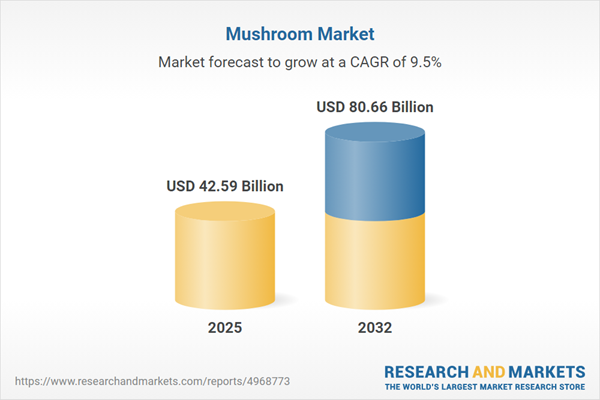Speak directly to the analyst to clarify any post sales queries you may have.
The mushroom market is undergoing transformative change, shaped by evolving sustainability goals, rising digitization, and a sharper focus on operational efficiency. For senior decision-makers, understanding these shifts is critical to navigating competition and steering organizations toward resilient, future-ready strategies.
Mushroom Market Snapshot: Growth and Outlook
In 2024, the global mushroom market reached a value of USD 38.90 billion. It is projected to rise to USD 42.59 billion in 2025 and is estimated to reach USD 80.66 billion by 2032. This reflects a robust compound annual growth rate (CAGR) of 9.54%. Key drivers fueling this upward trend include increasing demand for functional foods, greater integration into wellness and nutrition markets, and expanding investments in sustainable supply chain practices. The emergence of digital innovation and the need to keep pace with regulatory shifts further highlight operational agility as a core competitive advantage for companies operating in this evolving sector.
Mushroom Market Scope & Segmentation
This report presents comprehensive segmentation for leaders aiming to enhance risk management, strategic procurement, and growth planning. Each segment supports tailored solutions for diverse operational needs, enabling executives to align investments with changing industry trends and consumer preferences:
- Product Forms: Canned, dried, fresh (loose and prepacked), frozen, and powdered options provide flexibility for procurement teams and support a range of supply and distribution frameworks.
- Mushroom Varieties: Button, enoki, oyster, and shiitake mushrooms allow companies to serve mainstream consumers and reach specialty markets, supporting agile responses to evolving dietary demands.
- End Uses: Food and beverage, cosmetics, nutraceuticals, and pharmaceuticals expand application diversity, allowing entry into established industries and emerging growth segments.
- Distribution Channels: Supermarkets, specialty outlets, convenience stores, and ecommerce platforms broaden access and enable swift adaptation to changing sales environments.
- Nature: Conventional and organic production methods support clean-label and sustainability preferences, meeting the expectations of increasingly conscious buyers.
- Cultivation Methods: Greenhouse, indoor, and outdoor cultivation approaches help businesses optimize resources and sustainability goals across varied operational settings.
- Regions: Americas, Europe, Asia-Pacific, and Middle East & Africa, with a strategic focus on the United States, China, India, and Germany, support targeted expansion and precise risk management.
- Leading Companies: Monaghan Mushrooms Limited, Costa Group Holdings Limited, Greenyard NV, Bonduelle SA, OKE Champ Holding GmbH, Scelta Mushroom Company, Highline Mushrooms Ltd., Gourmet Fresh Mushrooms Pty Ltd, Nelson & Pade, Inc., and Matsuura Mushroom Co., Ltd. enable benchmarking and competitive intelligence for well-informed strategy formation.
Key Takeaways for Senior Decision-Makers
- Partnerships with biotechnology and wellness sectors open new innovation pathways, strengthening product portfolios and streamlining supply chains.
- Mycelium-based technologies enhance operational efficiency and support the development of sustainable protein alternatives to address evolving corporate responsibility strategies.
- Transparent sourcing and rigorous supply oversight underpin regulatory compliance and build trust across global operations, reinforcing stakeholder relations.
- Automation integrated into cultivation processes fosters agility in production, empowering organizations to quickly adapt to disruptions or sudden shifts in demand.
- Utilizing mushroom by-products promotes value creation and supports compliance with environmental standards, encouraging adoption of circular economy practices.
- Regionally customized strategies help navigate regulatory landscapes and optimize expansion into priority international markets, ultimately supporting better risk-managed growth.
Tariff Impact on Supply Chain and Trade Dynamics
With tariffs set to impact U.S. mushroom imports from 2025, organizations are adjusting sourcing and operational models to safeguard business continuity. Domestic producers are elevating automation and process optimization, while international suppliers differentiate products to maintain competitiveness. A diversified sourcing strategy and increased supply chain agility are now essential as companies respond to ongoing changes in the global trade arena.
Mushroom Market Methodology & Data Sources
This analysis utilizes direct interviews with producers, supply chain professionals, and key buyers, supplemented by thorough secondary research. Reference materials include peer-reviewed journals, patents, and detailed industry reports, offering a solid knowledge base for senior executive planning and risk assessment.
Why This Report Matters for Strategic Growth
- Provides deep market segmentation and actionable insights to identify opportunity and strengthen risk mitigation.
- Aligns operational data with key objectives across procurement, sustainability, and regional development.
- Supports compliance efforts and stakeholder engagement, delivering a resilient foundation for long-term positioning.
Conclusion
Access to actionable mushroom market intelligence supports senior leaders in building strategies responsive to changing industry dynamics and stakeholder needs, ultimately strengthening prospects for sustainable growth and enduring resilience.
Additional Product Information:
- Purchase of this report includes 1 year online access with quarterly updates.
- This report can be updated on request. Please contact our Customer Experience team using the Ask a Question widget on our website.
Table of Contents
3. Executive Summary
4. Market Overview
7. Cumulative Impact of Artificial Intelligence 2025
Companies Mentioned
The companies profiled in this Mushroom market report include:- Monaghan Mushrooms Limited
- Costa Group Holdings Limited
- Greenyard NV
- Bonduelle SA
- OKE Champ Holding GmbH
- Scelta Mushroom Company
- Highline Mushrooms Ltd.
- Gourmet Fresh Mushrooms Pty Ltd
- Nelson & Pade, Inc.
- Matsuura Mushroom Co., Ltd.
Table Information
| Report Attribute | Details |
|---|---|
| No. of Pages | 180 |
| Published | October 2025 |
| Forecast Period | 2025 - 2032 |
| Estimated Market Value ( USD | $ 42.59 Billion |
| Forecasted Market Value ( USD | $ 80.66 Billion |
| Compound Annual Growth Rate | 9.5% |
| Regions Covered | Global |
| No. of Companies Mentioned | 11 |









